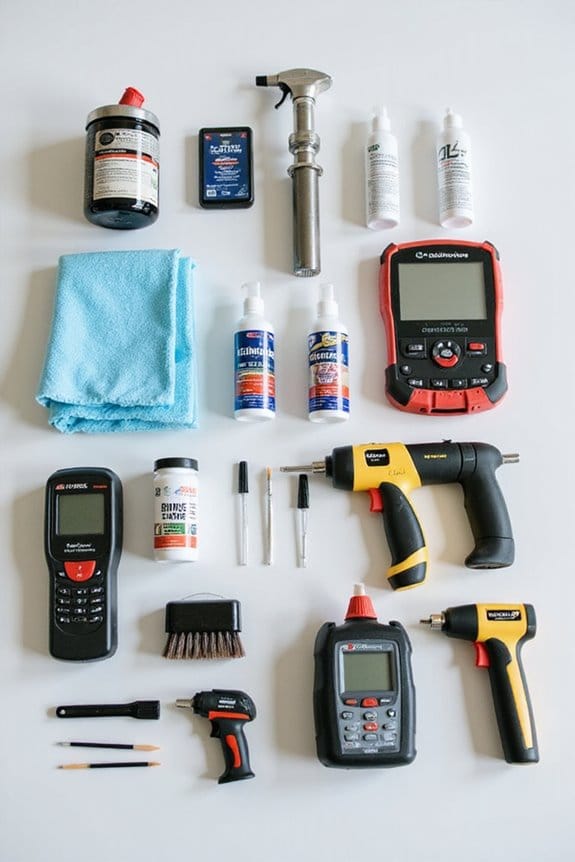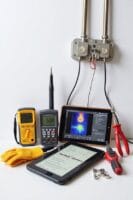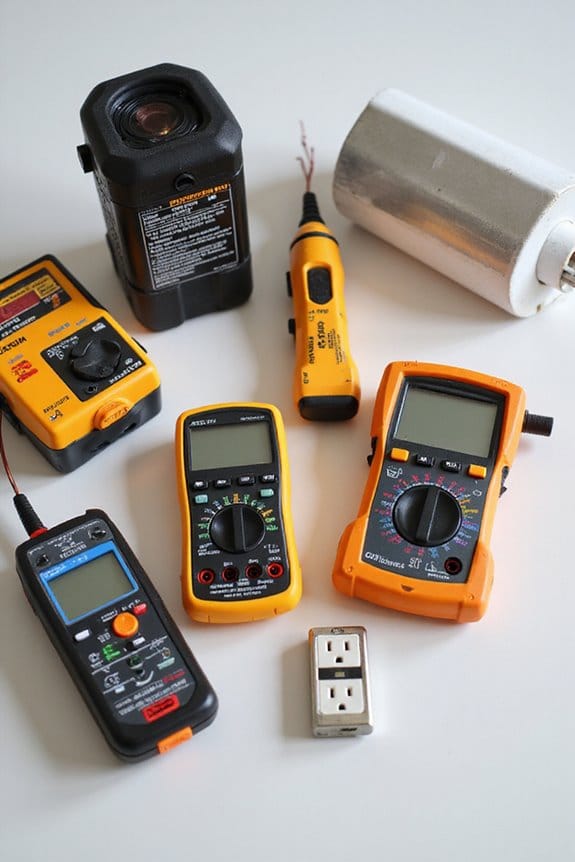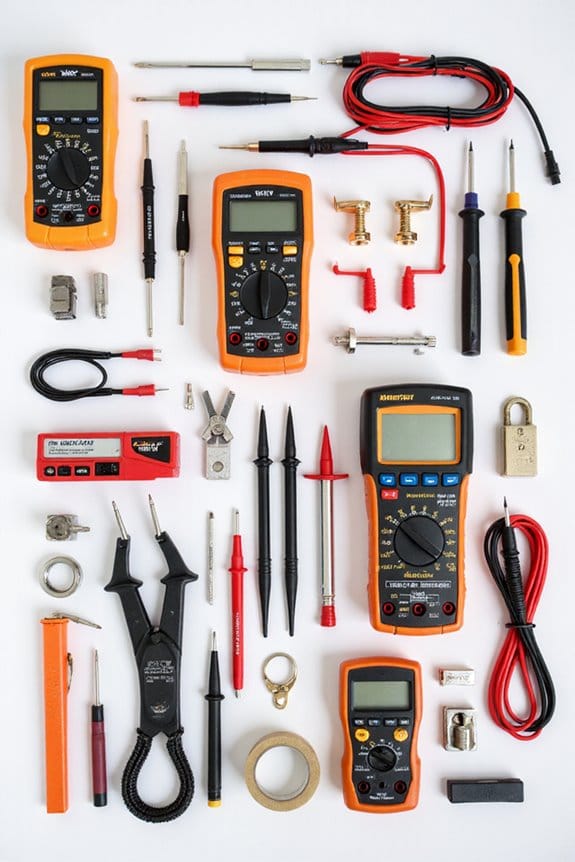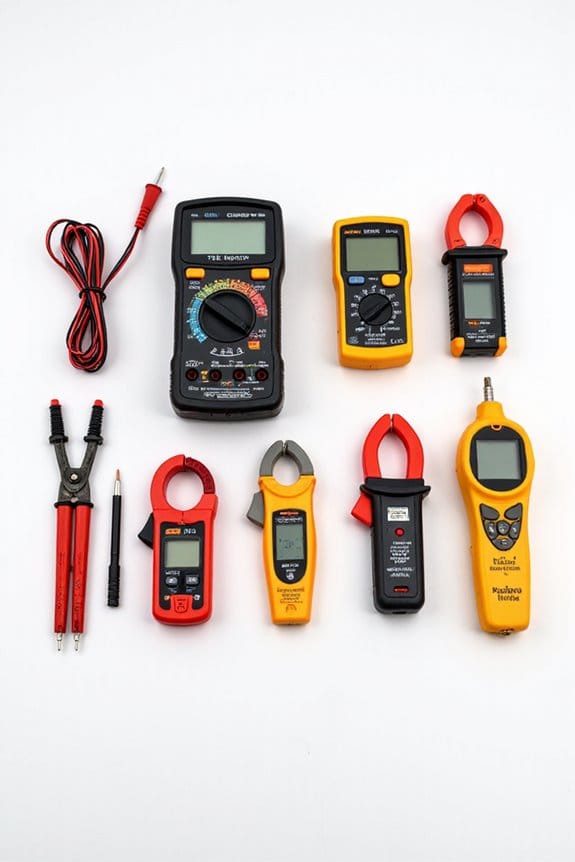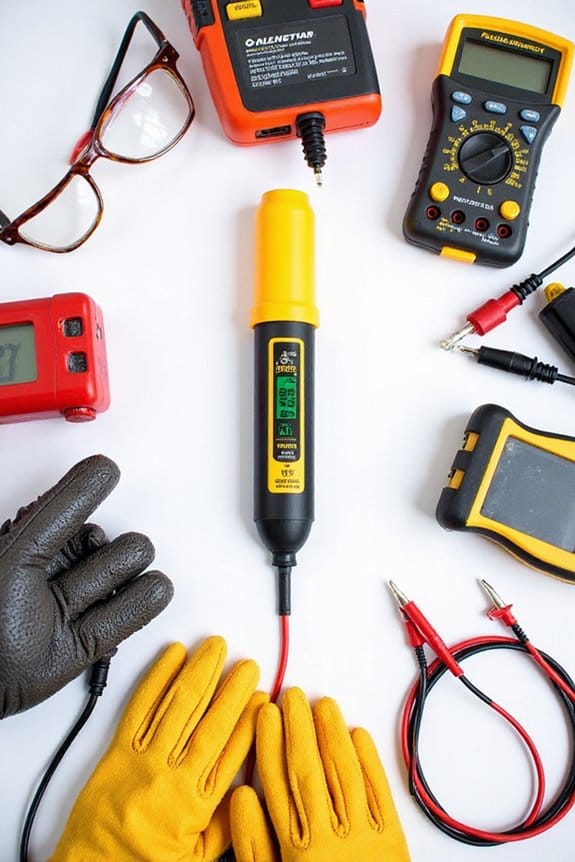When it comes to cleaning testing equipment, I’ve found a few must-have supplies. First, acidic and alkaline cleaners tackle mineral deposits and organic soils. Next, solvents help dissolve stubborn contaminants. Don’t forget specialized swabs and pre-moistened cloths for thorough surface testing! And let’s not overlook industrial tools like ATP testers for measuring biological contamination. These supplies make sure your equipment stays accurate and safe. Stick around, and you’ll discover even more about how to keep everything in prime shape!
Key Takeaways
- Use acidic and alkaline cleaners to effectively tackle mineral deposits and organic soils on testing equipment.
- Employ solvents to dissolve organic contaminants, ensuring sensitive parts remain unharmed.
- Implement cleaning wipes designed for delicate surfaces to prevent lint and residue transfer.
- Utilize specialized swabs and calibration standards for accurate surface cleanliness testing.
- Regularly incorporate ATP testing and monitoring tools to validate hygiene and contamination levels.
Types of Cleaning Supplies for Testing Equipment
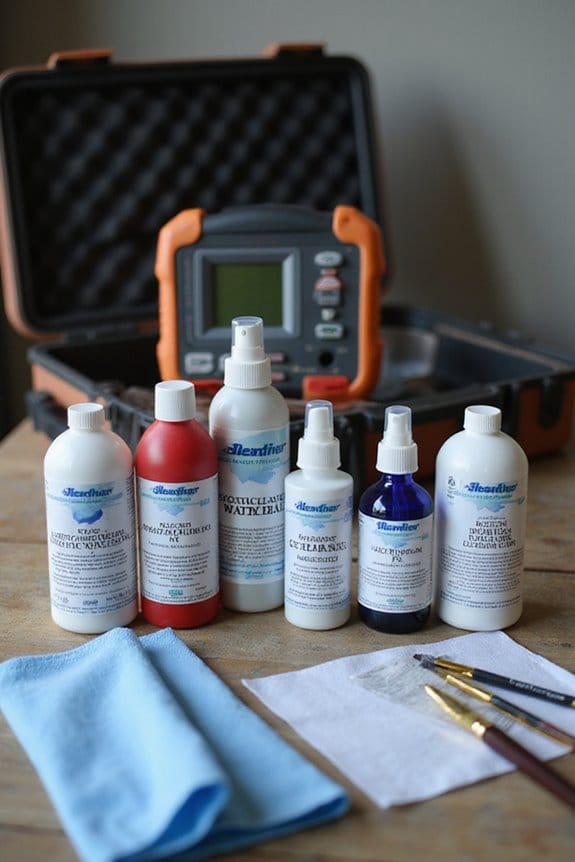
When it comes to cleaning supplies for testing equipment, having the right tools is vital. Here’s a quick rundown of what you’ll need:
- Acidic Cleaners: Perfect for tackling mineral deposits. Think hydrochloric or sulfuric acids.
- Alkaline Cleaners: These are great for organic soils—ideal for glassware.
- Solvents: They dissolve organic contaminants, particularly for sensitive parts.
- Sporicidal Agents: Essential for eliminating microbial contaminants in labs.
- Cleaning Wipes: Lint-free options designed for delicate surfaces.
Using these supplies not only guarantees effective cleaning but also supports your cleaning protocols and equipment maintenance. Trust me, investing in the right supplies saves time and headaches in the long run! Happy cleaning!
Cleaning Methods Relevant to Testing Equipment
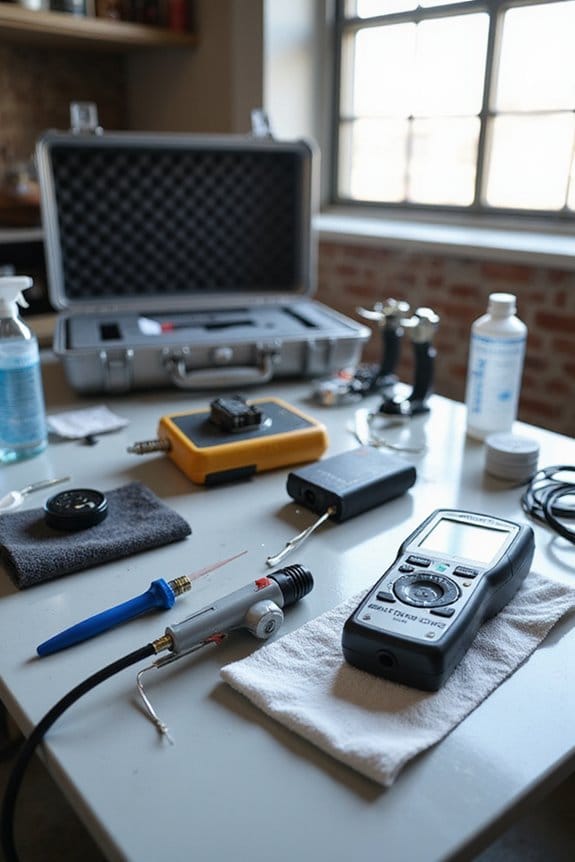
Cleaning testing equipment isn’t just about having the right supplies; it’s also about using effective methods. Here are some techniques I find useful:
- Mechanical Cleaning: Use soft, lint-free cloths or brushes to remove dust. For stubborn dirt, try non-abrasive sponges.
- Chemical Cleaning: Mix mild detergent with warm water for common residues. For tougher spots, solvents like ethanol work wonders, but be cautious!
- Thermal Cleaning: Rinse everything thoroughly and let it air dry. Gentle heat is okay, but don’t overdo it!
- Validation: After cleaning, check for residue to verify everything’s up to standard.
Following these cleaning protocols not only keeps equipment safe but also guarantees accurate results. Trust me, your tests will thank you!
Supplies for Surface Cleanliness Testing Equipment
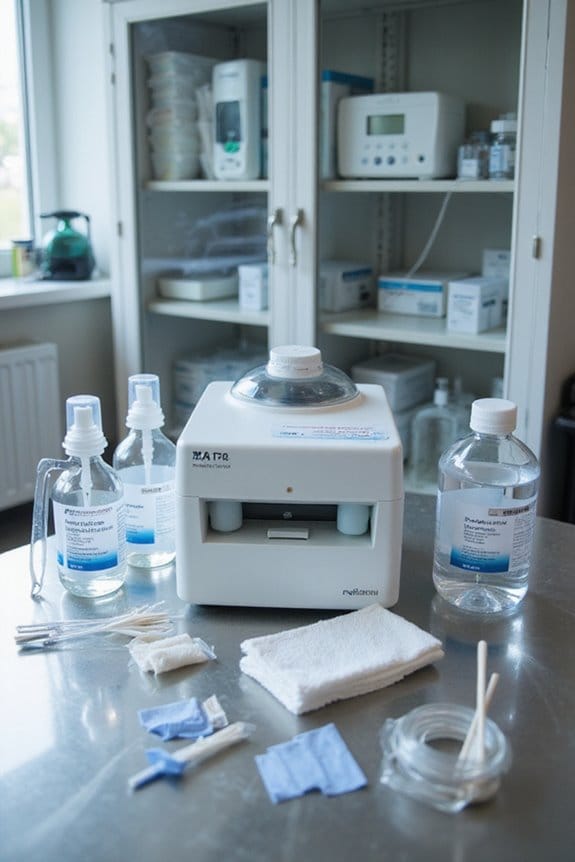
To guarantee accurate results in surface cleanliness testing, you’ll need the right supplies at your fingertips. Here’s a quick list of essentials:
- Pre-moistened or dry cloths: These help you avoid contamination while wiping surfaces.
- Specialized swabs: Use Bresle patches for collecting residues efficiently.
- Non-reactive solvents: They won’t interfere with your contamination assessment.
- Disposable gloves: Always wear these to prevent transferring any unwanted contaminants.
- Calibration standards: Tools like Dyne Test Fluids assure your surface analysis is spot on.
With these supplies, you’ll be well-equipped to tackle any surface cleanliness testing. Remember, a clean setup leads to reliable results—so don’t skimp on the details! Happy testing!
Labware Cleaning Supplies for Test Equipment

Labware cleaning supplies are crucial for keeping your test equipment in top shape. To achieve that, I recommend using specialized labware detergents tailored for glass, plastic, and metal surfaces. Here’s a quick list of my favorites:
- 7X™ Detergent: GMP compliant and effective at various concentrations without etching.
- Thermo Scientific Nalgene L900: Eco-friendly and gentle on plastic labware.
- Alconox Powdered Precision Cleaner: Great for healthcare instruments, leaving no residue.
Adhering to proper cleaning protocols is important, too. Always use appropriate soaking and rinsing techniques, and consider polypropylene trays for autoclaving. These supplies guarantee your labware stays pristine, prolonging the life of your valuable test equipment. Trust me, a little effort goes a long way!
Industrial Cleaning Tools Adapted for Testing Equipment
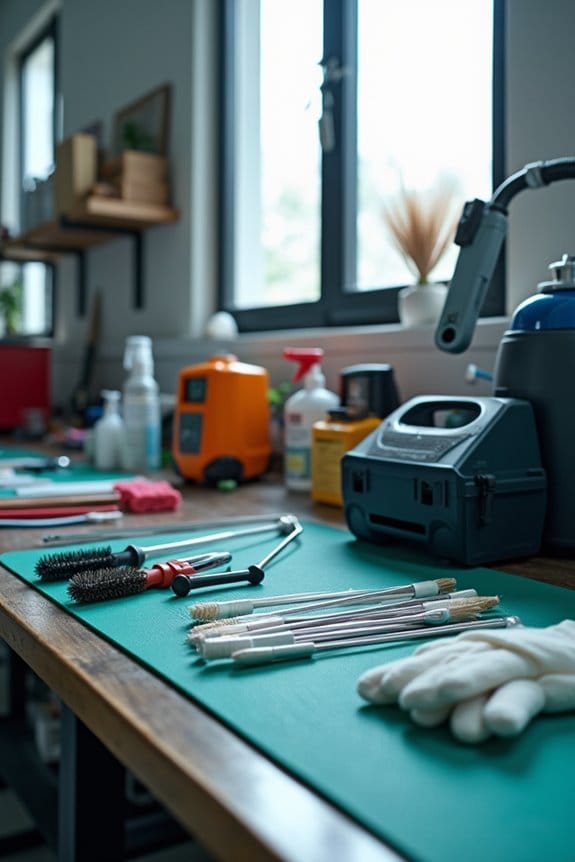
When it comes to ensuring your testing equipment stays free from surface contaminants, industrial cleaning tools are a game changer. Here’s why:
- SITA CleanoSpector: This handheld device detects organic contamination like oil and grease—perfect for metal surfaces.
- Dyne Test Fluids: Assess surface energy levels. Higher levels mean cleaner surfaces, reducing contamination risks.
- Inline Monitoring: Instruments like the SITA ConSpector keep an eye on contamination levels in industrial wash processes, ensuring cleaning validation.
- ATP Testing: Detects biological contamination, vital for hygiene validation in sensitive environments.
Regular use of these tools is essential for effective contamination detection. They not only enhance cleaning validation but also help maintain the integrity of your testing equipment. Trust me; you won’t regret it!
Frequently Asked Questions
Can I Use Regular Household Cleaners on Testing Equipment?
Did you know 70% of equipment failures are due to improper cleaning? I wouldn’t risk using regular household cleaners; they can damage sensitive surfaces. For safe cleaning and effective equipment maintenance, always choose products specifically designed for your devices.
How Often Should Cleaning Supplies Be Replaced?
I believe cleaning supplies should be replaced based on their longevity and cleaning frequency. Regular checks help guarantee effectiveness, especially if you notice any changes in smell or consistency. Always prioritize maintaining standards for ideal results.
Are There Eco-Friendly Cleaning Options Available?
Isn’t it time we embraced a cleaner future? I’ve discovered eco-friendly options like biodegradable wipes and plant-based solutions that make cleaning a breeze while protecting our planet. Let’s make sustainable choices together for a healthier environment!
What Is the Shelf Life of Cleaning Agents?
The shelf life of cleaning agents varies based on factors like formulation and storage conditions. I’ve noticed that proper packaging and environmental control can greatly extend their effectiveness and safety over time.
How Should Cleaning Supplies Be Stored?
Oh, the thrill of proper storage! I make sure my cleaning supplies are tucked away safely, away from sunlight, with safety measures like ventilation. A cluttered shelf? No thanks! I prefer my organization with a dash of flair!

